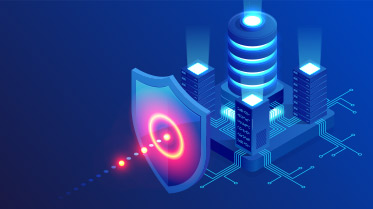July 18, 2022 - by Synoptek
The Cybersecurity Maturity Model
The cybersecurity maturity model is the process in which a computer security model enforces security policies. Understanding your organization’s vulnerability is the first step in identifying where your weaknesses lie. And with 70% of enterprises experiencing some level of attack or cybersecurity issue every year, your organization’s safety is more important than ever. Organizations must be ready to handle a cybersecurity incident at any given moment. To keep their data secure, they must develop a robust cybersecurity program that helps them remain attentive.
The Importance of the Cybersecurity Model
The cybersecurity maturity model is designed to help businesses understand where their company is in terms of securing their infrastructure. According to this, the company can decide what steps to take in order to improve their cybersecurity further. Data breaches are a major threat to any company; the effects of the breach can prove not only to be harmful to revenue but the relationship with your customer. A well-defined cybersecurity strategy maintains a constant lookout and protects data, networks, and applications from cyber threats 24/7.
How to Climb the Cybersecurity Maturity Model?
The day-to-day challenges of running a business often cause cybersecurity to take a backseat. But given the far-reaching implications of even a small data leak or security breach, it is becoming increasingly vital for organizations to put cybersecurity at the core of everything they do: from the technologies they implement, the processes they curate, and the decisions they make.
According to a recent Forrester report, 55% of security professionals reported an incident or breach in the past 12 months. Although most organizations today are investing in modern tools, robust cybersecurity is a lot more than just implementing a handful of controls; organizations need to first understand what stage of the cybersecurity maturity model they’re in and take steps to advance, eliminating vulnerabilities along the way. Read on to understand how your organization can progress.
At What Stage is Your Organization in the Cybersecurity Maturity Model?
Business leaders are increasingly realizing that successful IT implementations are key to driving greater agility, enhanced flexibility, and increased efficiencies. Although new technology adoption is critical to keep up with the pace of digital change, it needs to be done with a clear, conscious, and continuous focus on cybersecurity.
With the frequency and scale of security incidents swelling, there is a pressing need for organizations to evaluate the current level of cybersecurity and accordingly drive efforts in raising awareness and training users to become the champions for cyber safety. So, where does your organization stand in the cybersecurity maturity model? Does your organization have standardized and repeatable cybersecurity processes in place? Have you invested in the latest security tools and technologies? Is your workforce trained in basic cybersecurity controls? Do you have a robust change management strategy in place? Let’s answer those questions.
The Different Stages of Security Maturity
Maturity models present a collection of best practices and help determine the degree of adherence by organizations of different types and sizes. Savvy business leaders are realizing that successful IT implementations are crucial to growth. A model such as Synoptek SECURES allows clients to build a foundation while climbing the maturity model. Committing to a maturity model means the organization has committed itself to improving its processes and practices within a model’s domains to a sustainable, measured level of high performance. That being said, let’s look at the 5 different stages of security maturity:
Chaotic
Organizations at the lowest level of the maturity model have an extremely chaotic approach to cybersecurity. There are no defined processes for cybersecurity and people have no idea of which security risks they are vulnerable to or how they need to act if a breach occurs. Such organizations are extremely prone to attacks and stand the risk of being hacked.
Ad-hoc
Organizations at this level of the cybersecurity maturity model have minimal cybersecurity awareness; they undertake just basic measures to safeguard the business and its data from attacks and breaches. There is little or no inclusion of cybersecurity policies and procedures in day-to-day business operations and users do not have a clear idea of how to deal with breaches, if and when they occur. Most users take a fire-fighting approach to thwart the impact of attacks and have just basic cybersecurity tools in place.
Defined
At this stage of the security maturity model, roles and responsibilities are clearly defined. A decent number of tools and technologies have been implemented for security purposes and users know which tools to use or what approaches to take to minimize the impact of a breach.
Advanced
Organizations at the Advanced level have defined and repeatable cybersecurity measures in place; users are trained on how they need to react when a breach occurs and have the required knowledge about using modern tools and practices to safeguard the business against attacks. However, most approaches to cybersecurity continue to be reactive, and users do not have the skills or capabilities to prevent attacks from happening.
Predictive
For organizations at this level of the maturity model, cybersecurity is ingrained into the DNA of business operations. Instead of being reactive, cybersecurity policies and procedures are multi-layered and predictive. Necessary tools are implemented to detect gaps and vulnerabilities. Business leaders and users alike take a risk-based approach and have been trained in identifying loopholes and thwarting attacks before they happen.
Advancing Through the Cybersecurity Maturity Model
If you want effective, efficient, and practical cybersecurity inside your environment, you need to constantly work towards advancing to the next stage of the maturity model. Here are some tips to keep in mind:
- Take a deep dive into security processes, strategies, and controls you currently have across your organization and conduct a security health check
- Understand your current strengths and weaknesses and build a rough roadmap to advance your organization’s security posture
- Carry out a detailed Asset Inventory to arrive at a list of existing and newly discovered devices as well as to identify malicious ones
- Conduct an independent discovery process around existing domains and identify assets that are no longer in use
- Monitor the enterprise network for early signs of leaks, misuse, or breaches and set up a robust Security Information and Event Management (SIEM) strategy in place
- Implement necessary antivirus and antimalware tools to secure endpoints and set up multi-factor authentication mechanisms to protect the enterprise against unwanted attacks and minimize the threat profile
- Invest in advanced backup and encryption tools, but don’t be under pressure to implement everything at once; understand what your organization needs on priority and embrace additional services and protections over time
- Create a culture of cybersecurity across the enterprise, take a security-first approach, and train employees at every level on basic cybersecurity measures and practices
Amid the evolving digital landscape and emerging cyberthreats, improving your organization’s cybersecurity maturity is critical. Advancing to the next stage of the maturity model requires a thorough cybersecurity assessment of existing controls and processes and a robust roadmap that lists the steps you need to take, the tools you need to implement, and the awareness you need to create to optimize cybersecurity and make it as agile and business-focused as possible.


